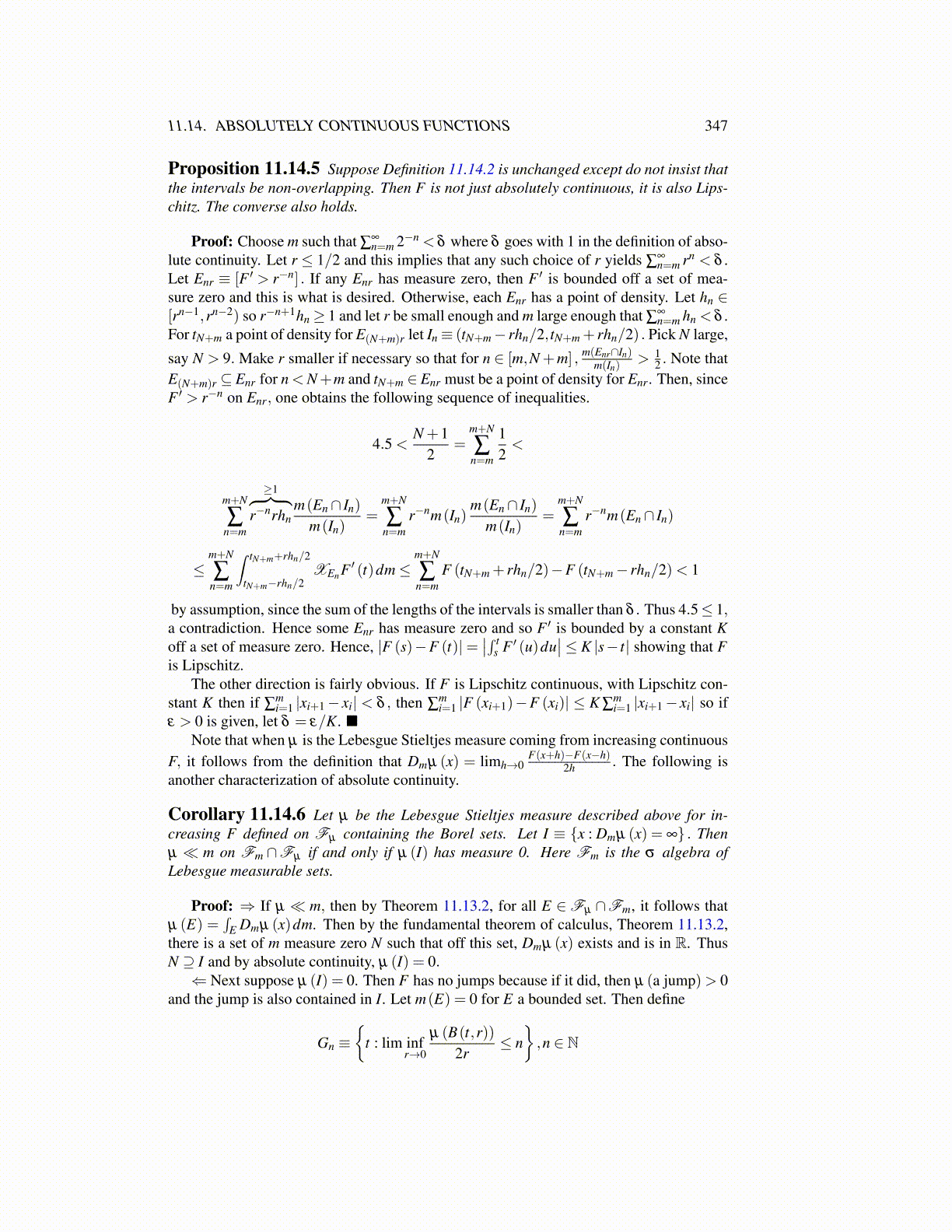
11.14. ABSOLUTELY CONTINUOUS FUNCTIONS 347
Proposition 11.14.5 Suppose Definition 11.14.2 is unchanged except do not insist thatthe intervals be non-overlapping. Then F is not just absolutely continuous, it is also Lips-chitz. The converse also holds.
Proof: Choose m such that ∑∞n=m 2−n < δ where δ goes with 1 in the definition of abso-
lute continuity. Let r ≤ 1/2 and this implies that any such choice of r yields ∑∞n=m rn < δ .
Let Enr ≡ [F ′ > r−n] . If any Enr has measure zero, then F ′ is bounded off a set of mea-sure zero and this is what is desired. Otherwise, each Enr has a point of density. Let hn ∈[rn−1,rn−2) so r−n+1hn ≥ 1 and let r be small enough and m large enough that ∑
∞n=m hn < δ .
For tN+m a point of density for E(N+m)r let In≡ (tN+m− rhn/2, tN+m + rhn/2) . Pick N large,
say N > 9. Make r smaller if necessary so that for n ∈ [m,N +m] , m(Enr∩In)m(In)
> 12 . Note that
E(N+m)r ⊆ Enr for n < N+m and tN+m ∈ Enr must be a point of density for Enr. Then, sinceF ′ > r−n on Enr, one obtains the following sequence of inequalities.
4.5 <N +1
2=
m+N
∑n=m
12<
m+N
∑n=m
≥1︷ ︸︸ ︷r−nrhn
m(En∩ In)
m(In)=
m+N
∑n=m
r−nm(In)m(En∩ In)
m(In)=
m+N
∑n=m
r−nm(En∩ In)
≤m+N
∑n=m
∫ tN+m+rhn/2
tN+m−rhn/2XEnF ′ (t)dm≤
m+N
∑n=m
F (tN+m + rhn/2)−F (tN+m− rhn/2)< 1
by assumption, since the sum of the lengths of the intervals is smaller than δ . Thus 4.5≤ 1,a contradiction. Hence some Enr has measure zero and so F ′ is bounded by a constant Koff a set of measure zero. Hence, |F (s)−F (t)|=
∣∣∫ ts F ′ (u)du
∣∣≤ K |s− t| showing that Fis Lipschitz.
The other direction is fairly obvious. If F is Lipschitz continuous, with Lipschitz con-stant K then if ∑
mi=1 |xi+1− xi| < δ , then ∑
mi=1 |F (xi+1)−F (xi)| ≤ K ∑
mi=1 |xi+1− xi| so if
ε > 0 is given, let δ = ε/K. ■Note that when µ is the Lebesgue Stieltjes measure coming from increasing continuous
F, it follows from the definition that Dmµ (x) = limh→0F(x+h)−F(x−h)
2h . The following isanother characterization of absolute continuity.
Corollary 11.14.6 Let µ be the Lebesgue Stieltjes measure described above for in-creasing F defined on Fµ containing the Borel sets. Let I ≡ {x : Dmµ (x) = ∞} . Thenµ ≪ m on Fm ∩Fµ if and only if µ (I) has measure 0. Here Fm is the σ algebra ofLebesgue measurable sets.
Proof: ⇒ If µ ≪ m, then by Theorem 11.13.2, for all E ∈Fµ ∩Fm, it follows thatµ (E) =
∫E Dmµ (x)dm. Then by the fundamental theorem of calculus, Theorem 11.13.2,
there is a set of m measure zero N such that off this set, Dmµ (x) exists and is in R. ThusN ⊇ I and by absolute continuity, µ (I) = 0.⇐ Next suppose µ (I) = 0. Then F has no jumps because if it did, then µ (a jump)> 0
and the jump is also contained in I. Let m(E) = 0 for E a bounded set. Then define
Gn ≡{
t : lim infr→0
µ (B(t,r))2r
≤ n},n ∈ N